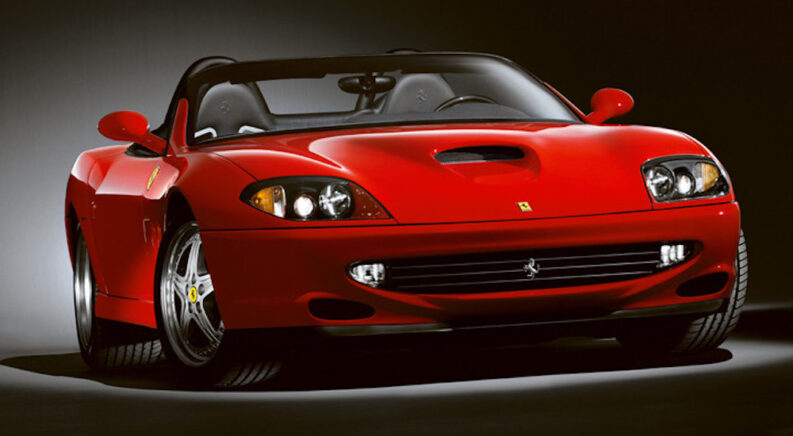A grand collection of supercars was dismantled back in November 2022, going for auction at RM Sotheby’s in London. On that momentous day, 18 of the most significant cars of the modern era were offered for sale, ending the Gran Turismo Collection’s 25-year run while sending me on an interminable journey to explore each of the car’s histories and legacies. Today that adventure leads me to a 2000 Ferrari 550 Barchetta Pininfarina, chassis #124064 to be exact. It was the second longest tenured member of this extended family. Owned since new, only the collector’s F40 preceded it in that illustrious garage.
A Birthday Present to Themselves
The 550 Barchetta Pininfarina, as with any special Ferrari, had a limited run of only 448 units. As the popular story goes, it would’ve been 444, but the Japanese have superstitions about that number. It was based on the 550 Maranello coupé, with a number of distinct styling tweaks to celebrate Pininfarina’s 70th anniversary. Most pronounced among them was the elimination of a permanent roof and the intensified rake of the windshield, which lowered it by 100 mm. Little did we know then that this understated Ferrari, if there could be such a thing, would effectively represent the last manual, front engine, V12, open roof Ferrari ever made.
Not that there are many vehicles fitting such a description, but their significance should lend weight to that of the 550 Barchetta Pininfarina. The 166 MM, 250 California, and 365 GTS/4 “Daytona” are its predecessors in this hallowed tradition. The 550 was the first time since the 1970s that Ferrari had offered a front-engine V12 twio-seater at all. Both Car & Driver and Goodwood rank the 365 GTB/4 Daytona in their top 10 greatest Ferraris of all time. It stands to reason that, in time, we may view the 550 in a similar light as the ultimate installment of that timeless tradition.
The Gentleman’s Ferrari
It would seem that the practical outcome of mounting a 486 hp naturally-aspirated V12 engine in front of the passenger compartment is the taming of the beast. Where typical low, wide, mid-engined sports cars might feel like they’re always a little bit on-edge, that high-strung attitude is lost in the 550 Barchetta Pininfarina. All of the power and quickness is still there. A 0-60 time of 4.4 seconds was a proper supercar number at the turn of the millennium. The balance achieved by mounting the transmission in the rear, in a single unit with the rear limited slip differential, recalls the spirit of those great Ferraris which preceded it. Plentiful carbon fiber adorning the interior, including the shifter knob, shows remarkable prescience about the future of the industry. Meticulous attention to weight savings opportunities, such as the use of carbon fiber, ensured that the Barchetta Pininfarina, despite needing a stiffer structure to make up for the lack of a roof, would weigh in at the same 3,725 lbs as the Maranello.
For all the glory of its sonorous roar, the magnificent V12 is relaxed and smooth at idle. It starts with a whirr instead of a bark, and happily manages laid-back cruising without complaint, unlike some Ferrari powertrains which are known to actively rebel against living below 3,000 rpm. The car is narrow enough to manage lanes, and tall enough to comfortably climb in and out. Its long hood and extended front overhang seem to be more informed by ‘60s and ‘70s style than the mid-1990s. Ferrari might not be known for making grand tourers today, but up until the 365 GTB/4, that was their bread and butter identity. The 550 Barchetta Pininfarina represents a transcendent ode to that heyday of Ferrari’s fast-rising star.
Virtual Reality
Despite all of that, the 550 Barchetta Pininfarina is a forgotten Ferrari, seemingly lost to the collective consciousness between the more famous Testarossa, F50, Enzo, and 360 Modena that surrounded it. The Need For Speed video game franchise acknowledged its importance in Hot Pursuit 2, where a 550 Barchetta Pininfarina was a mid-tier lawbreaker and one of two models (the other being the 360) to feature a cockpit perspective camera option. This was my introduction to the car, and frankly the only place it’s ever crossed my path. Seeing its picture is like bumping into a celebrity from my childhood, a reminder that this was real, and the real version was more beautiful than I ever could have known.
We have not, collectively, chosen to honor the 550 Barchetta Pininfarina with the badge of an icon. I doubt its poster graces many walls. Its owners might prefer it that way. The unique body shape and overall style implies a willingness, if not a desire, to fly under the radar. Not every Ferrari driver wants to make heads turn or strike up conversation with gawkers wearing New Balance shoes at the gas station. Indeed, though it might not be as famous as Ferrari’s turn-of-the-century mid-engined sports cars, the market has reflected an acknowledgement of its rarity and specialnes. Auction prices generally show appreciation on-par with inflation, compared to the depreciation experienced by the more popular 360 Modena and Testarossa.
With that anonymity seems to have come inconsistency. The 550 Barchetta Pininfarina was sold for around $250,000 back in 2000, and averages about $450,000 at auction today. But this value has generally varied wildly over the past decade, with records exceeding $700,000 and others showing no appreciation at all. For an example of this, look no further than our case study of the day, chassis #124064.
Chassis #124064
In many ways, the second longest tenured car in the Gran Turismo Collection was a far cry from the Ferrari F40 which predated it. Its cylinders were larger and more numerous. It made more power, though much less per liter of displacement, and just a hair less torque. The F40 used composites and super-wide rear tires. The stagger of their track widths are reversed. The 550 weighed a half-ton more, and that was just enough for the F40 to be decidedly quicker, though not by much, in a straight line. But today, the F40 is worth three times as much, even though three times as many were made.
Chassis #124064 was delivered in classic Rosso Corsa over Nero leather livery, and has been maintained as religiously as any other car in the garage. It should be a magnificent cruiser, featuring the relatively rare Fiorano handling package that incorporated a 10 mm height reduction from stiffer springs, a more direct steering rack, special brakes, and an enameled, hand-painted Scuderia badge on each wing panel. Yet the owner showed their preference for the supercars by the mileage accumulated. They drove the F40 about 80 miles per month, while #124064 was barely driven 200 miles per year, and had accumulated only 4,753 miles by the time of the auction.
I don’t suppose we can blame them. A barchetta is, by definition, vulnerable to the elements, and a collection in the UK is subject to Mother Nature’s whims. How many days were they struck by the fancy to take #124064 for a spin, only to be foiled by the forecast? Not to mention that, as a non-halo car in the Ferrari lineup, mileage is money. If preserving the odometer was about money, I can’t help but wonder if the decisions to repaint it in Giallo Fly, or to install a six-pipe Koenig-Specials exhaust, were ultimately self-destructive. Given the care applied and low mileage accumulated, I suspect those changes are what’s to blame for this car’s sale price, which fell right in the middle of the projected range at about $257,000 USD, almost exactly what this car would have been sold for 23 years ago and 40% less than average.
I lament the strange fate of chassis #124064, having been owned by a doting enthusiast but rarely driven, and to no economic benefit to speak of. I also wonder how rare I am, to be someone who has known of this car and could instantly recognize it for many years thanks to my Playstation 2, and suddenly find myself desiring this car as though I could appreciate it more than the unfeeling masses. While this is true, I have little doubt the 440 or so actual owners of the 550 Barchetta Pininfarina believe that, with some TLC and enough time, the last open-air V12 Ferrari grand tourer may one day approach the hallowed status of the 365 GTS/4.
On the other hand, perhaps the low value of #124064 will prompt its new owner to drive it, weather permitting. Regardless of where the market goes, this one seems doomed for the low end of the spectrum, so it might as well be enjoyed. The sole purpose of a barchetta is to provide the most intimate connection between the driver and the drive, its intent is fulfilled by cruising on sunkissed roads in a beautiful countryside.
A Toast to Days Gone By
The Ferrari 550 Barchetta Pininfarina appears destined to remain one of the last true examples of this rare automotive format. Designed with a retro feel, with a simple but modern interior, and an experience wholly focused on crushing miles in beautiful fashion, it was made for more than a pedestal. I doubt it’ll ever be viewed as one of the great Ferraris. It’s too unknown or left out by the zeitgeist to generate the goodwill of nostalgia which would elevate it to such a status.
However, it should be safe to say the 550 Barchetta Pininfarina is destined for greatness in the market as a whole. As electrification becomes the rule and not the exception, interest in its classic and significant powertrain will grow. The test of that theory may come when chassis #124064 next changes hands. Perhaps by that time, the market will more deeply appreciate Ferrari’s grandest tourer.





